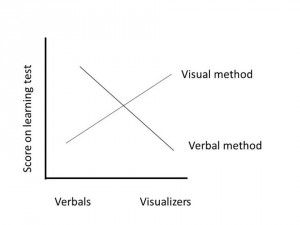Time to Put the Learning Styles Myth to Rest
One of the most widely-held beliefs about presentations and about learning is the idea that people have a preferred learning style—auditory, visual, or kinesthetic—so students learn more when the lesson is delivered in their learning style. A study cited in yesterday’s Wall Street Journal found that 94% of secondary school teachers they surveyed believed this is true.
And it’s not just teaching—a lot of sales experts tell us that we can sell more by using this idea: “Let’s see what the numbers look like. How does that sound to you?” (Full disclosure: I used to teach the idea in my own sales training, until I saw the science.)
Here’s a neat little experiment and accompanying visual that Richard Mayer reports in his book, Applying the Science of Learning. They first asked students a questionnaire to have them self-assess whether they were visual or verbal learners, and the strength of their preference. (e.g. “strongly more verbal than visual” compared to “slightly more visual than verbal”). They then taught a lesson to two randomly chosen groups, one in a verbal style and one in a visual style.
If the phenomenon does work, you would expect results to look something like this:
Instead, this is what the actual results looked like:
The first conclusion that can be drawn from these results is that even if Dick sees himself as visual, and Jane considers herself to be a verbal learner, they both learn the same amount, under either teaching style.
The second point is that the visual method results in greater learning, regardless of personal preference. As you can see, we are all visual learners.
Why should a salesperson care about this? There’s enough to keep track of in a sales conversation without spending valuable bandwidth worrying about the customer’s learning style and trying to change pick the right word to suit. Forget these tricks, and focus instead on sincerely understanding the customer’s needs and motivations, and on clearly explaining the value you bring.
I trust you hear my message loud and clear, that you see what I mean, and that you can wrap your arms around this concept.






[…] evidence to support it. Learning theorist Richard Mayer illustrated the weakness of the idea with one experiment that I’ve written about, and another famous example in the literature is described in John Medina’s book, Brain Rules. He […]